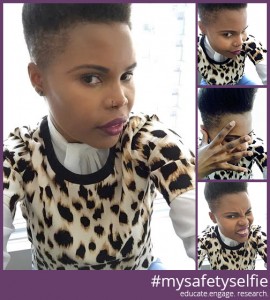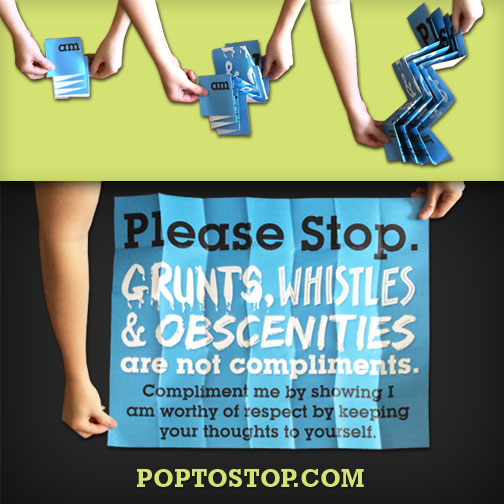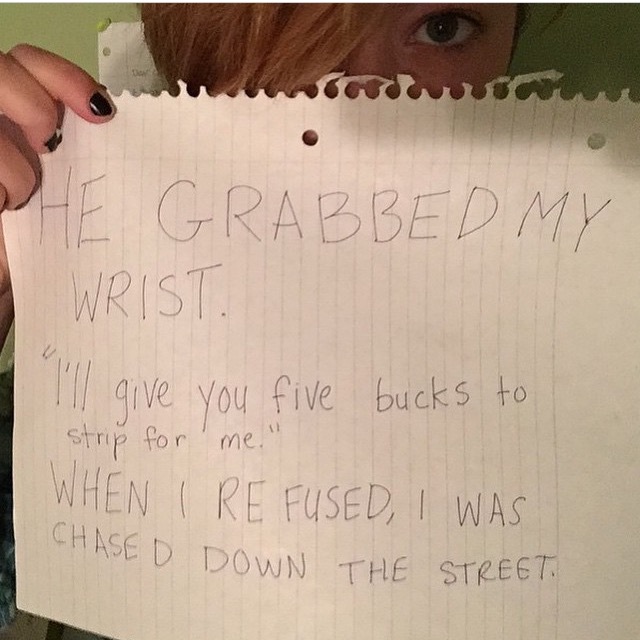 For many women, the streets are not ‘public’ spaces. Rather, they are places where our actions and clothes are judged by others, and our feelings of security are put into question. This often occurs in the form of sexual harassment or assault, an encounter which is intimidating, demeaning, invasive and frustrating. I would like to add here that I fully acknowledge that various forms of sexual harassment and assault are also suffered by men and transsexual people.
For many women, the streets are not ‘public’ spaces. Rather, they are places where our actions and clothes are judged by others, and our feelings of security are put into question. This often occurs in the form of sexual harassment or assault, an encounter which is intimidating, demeaning, invasive and frustrating. I would like to add here that I fully acknowledge that various forms of sexual harassment and assault are also suffered by men and transsexual people.
These experiences don’t stop when we step from the street onto London’s public transport and so I was relieved when I heard of an initiative called Project Guardian. As stated on its website, it is a ‘long-term project involving British Transport Police (BTP), Transport for London (TfL), Metropolitan Police and the City of London Police, which aims to reduce sexual assault and unwanted behaviour on public transport in London’. Apart from the name, which implies that women need to be protected rather than needing to be given a platform and the agency to strengthen and empower themselves, it is a wonderful and much needed project.
Given that Project Guardian has been running for nearly two years, when I excitedly mentioned it to friends of mine living in London I expected them to be aware of it, yet none of them were. I wondered if these responses represented a wider trend and so I created a survey in January 2015 asking Londoners of their knowledge of Project Guardian. The results were shocking: 84.3% of respondents using London transport ‘daily’ or ‘once or twice a week’ ‘have not heard of [Project Guardian] & don’t know what it is’ and 13.8% of respondents ‘have heard of it but don’t really know what it is’. Equally 72.8% did not know that ‘lewd comments or leering’ are reportable offences. Yet, when the initiative was explained almost all of the respondents were supportive of its aims and thought it to be a valuable and needed service.
My findings contrasted with an article in the Guardian from October 2013, written by Laura Bates, who’s illuminating Everyday Sexism project helped to advise the Project Guardian team. The article implied that the ‘20% increase in the reporting of sexual offences on the transport network’ was due to the launch of Project Guardian in April that year. However, I doubt the reliability of this claim because my findings show that very few Londoners have even heard of Project Guardian.
This trend is not surprising given that no posters advising passengers of what Project Guardian is and how to use it exist on the London transport network. I started to wonder why this was so, given the endless stream of TfL posters advertising other safety and security issues. I contacted TFL asking if there was a planned poster campaign, given that in September 2014 it was reported in the Londonist that Boris Johnson and Peter Hendry (Transport for London Commissioner) had said that such a campaign was planned. Their response was that ‘an integrated communications campaign is in development’. This came in April 2015 in the form of a social media based campaign called ‘Report It To Stop It’. On the launch day, BTP said that there are no plans for posters in the pipe line but ‘we have more than 300,000 handouts ready plus a big digital campaign to spread the word’.
Whilst a positive move by the Project Guardian team, this recent effort seems insufficient. Aside from the absence of a trigger warning on the rather graphic short film, it is also problematic as it is ‘aimed at women aged between 16 and 35’. I am campaigning for Project Guardian posters on the London Transport system because this way, a zero tolerance policy surrounding sexual harassment and assault will be clearly stated to all members of this public, including potential perpetrators. This would be more effective than a campaign only directed at potential victims. A short film and a few thousand leaflets can’t compete with the publicity generated by a widespread and permanent poster campaign.
Aside from the practical advantages of a poster campaign, I want to see Project Guardian given equal priority to combating other safety and security issues. There are currently 40 different poster campaigns on the transport network including those telling passengers ‘Please don’t play your music too loud’ and to be ‘Beware pickpocket’s tactics’. While these are valid safety & wellbeing concerns, it is outrageous that an issue so serious as sexual harassment and assault is not deemed worthy of a poster campaign. It’s ironic to note that TFL recently allowed the body-shaming adverts from Protein World on Tube platforms, but they don’t think Project Guardian posters are needed. This seems to echo the universal lack of recognition for women’s issues and the often contradictory messages surrounding them.
I did not start this campaign because I believe that law enforcement is the only, or most important, means of change. However, I believe that as a society we have normalised this form of violence against women and therefore posters informing the public that these are reportable offences are needed. Not only do the perpetrators need to know that this will not be tolerated, but those who have experienced sexual harassment or assault need to know that they will be listened to, taken seriously and supported in their responses by both police and surrounding members of the public. It needs to be clearly communicated that reportable offences include sexual touching, exposure, outraging public decency, lewd comments, leering and harassment, for which Project Guardian provides a specialist phone and text line through which to contact them.
Please help to support this campaign by following our Twitter page and tweeting us with your photos of TfL’s current posters and ask them why there aren’t any for #ProjGuardian.
Please tell friends and family about Project Guardian and keep your eyes out for the petition coming soon!
Matilda campaigns for women’s rights and against street harassment, founded Underreported Street Harassment and is a recent graduate from University of Leeds, UK.




